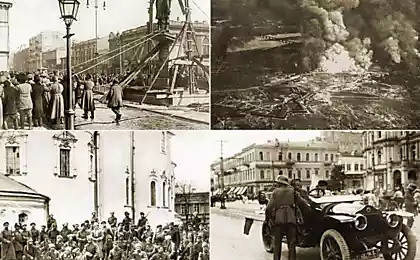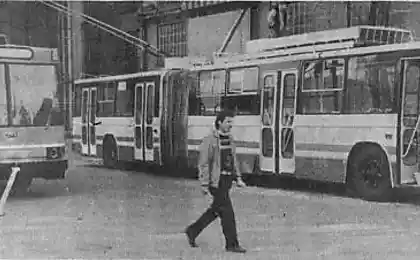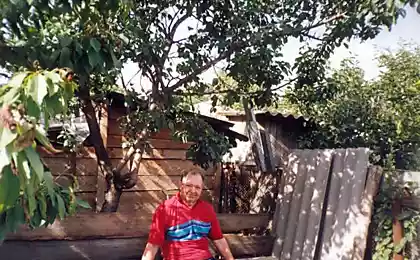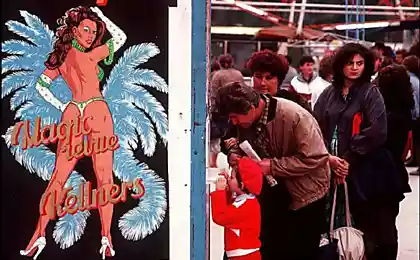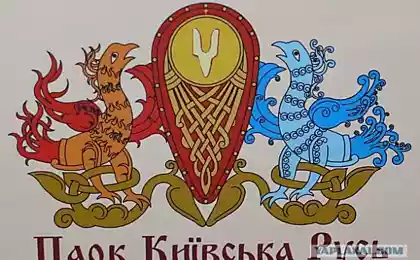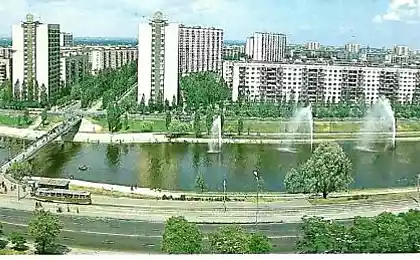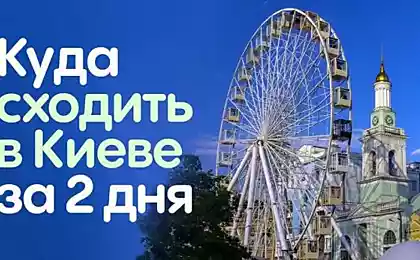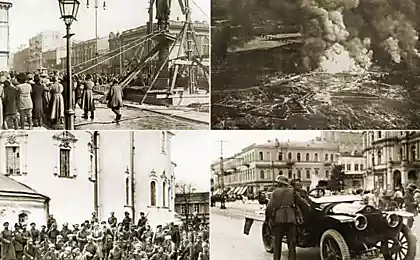921
Kiev in May (50 ph)
1. Select the first of May in Kiev, I decided to slightly dilute the friendly gatherings with Kiev YaPovlyanami proshvyrnutsya and still in the city, because there was a long time and much was forgotten / changed. Sim and share. For quality - do not expect anything grand, camera phone More Film.
Monument to the founders of Kiev - Polyansky princes Kyi, Schek, Horeb and their sister Lybid. Despite the fact that the monument was opened only in 1982, it can rightly be called one of the most recognizable symbols of the city. On the square in front of the monument is constantly stop wedding procession. According to local custom, we must try to throw the bouquet on the sloping deck boat and then a happy marriage provided!
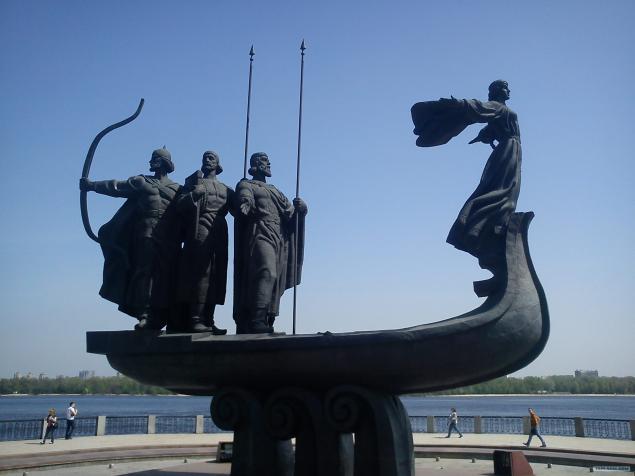
2. Close lurking lock tree - task to be easier for those with throwing bouquets did not succeed!
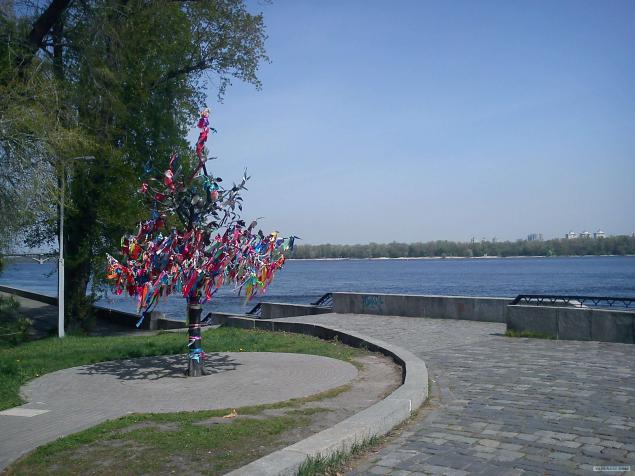
3. A boat rages behind the Dnieper.
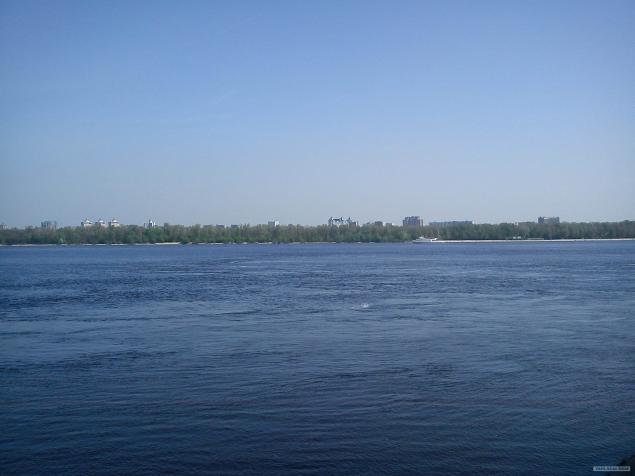
4. In contrast, on the right bank of the Dnieper rises the monument to Motherland, who with a light hand opens a monument to Leonid Ilyich (zvukorezha and carefully includes not just the microphone) was named Baba. And Baba colossal sword - 9 m., Panel - 13 tons. The spectacle is impressive even from a distance. Closer this time to get close failed.
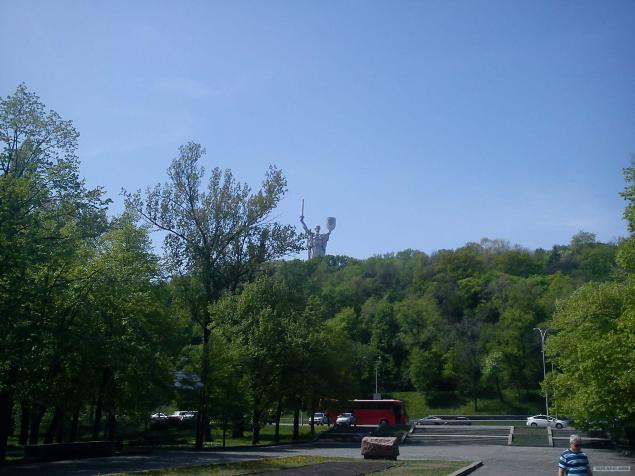
5. In the Park of Eternal Glory tourists were few, but they were scattered so gracefully that constantly climbed into the frame, and had to take a picture vlёt. So horizon ... Go to the monument of Eternal Glory with the eternal fire leads a small alley which transferred 35 military graves, 12 of them - Heroes of the Soviet Union.
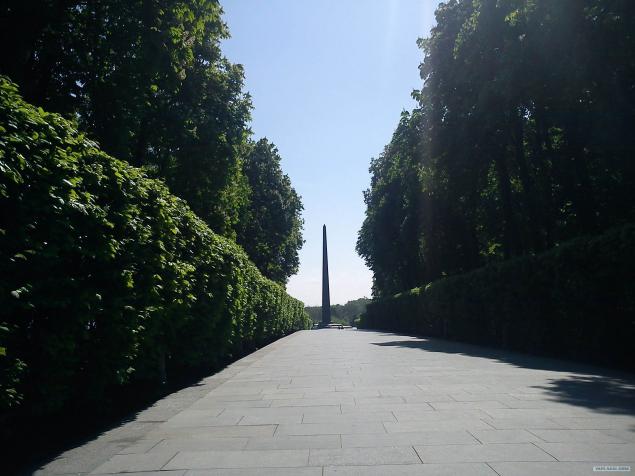
6. Next to the park is a monument to Ivan Niktovichu Kozhedub, the most effective Soviet ace of Great Patriotic War. Ivan himself Nikitivich native of Sumy region.
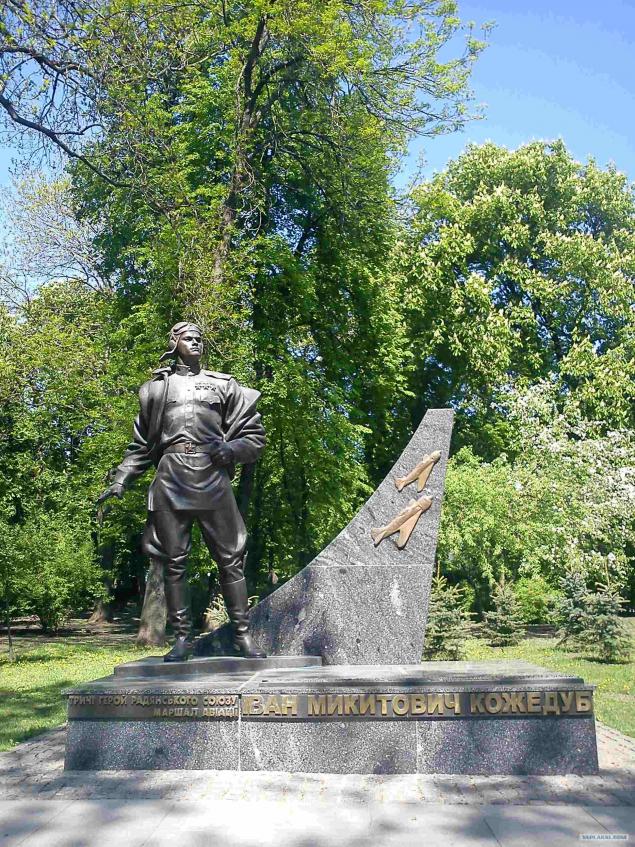
7. From the park offers a beautiful view on the left bank of the Dnieper. Only my phone this estimate does not, but if you're there - understand!
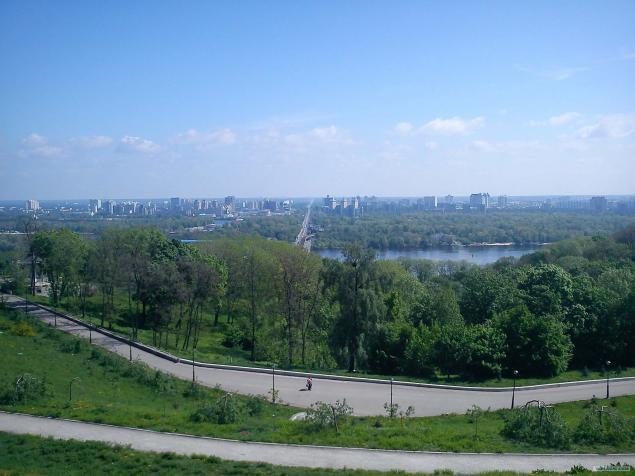
8. A little away from the park on the Alley of Heroes Krut (about them later) installed very sincere small monument to Leonid Bykov in the form of squadron leader Titorenko dedicated to military pilots.
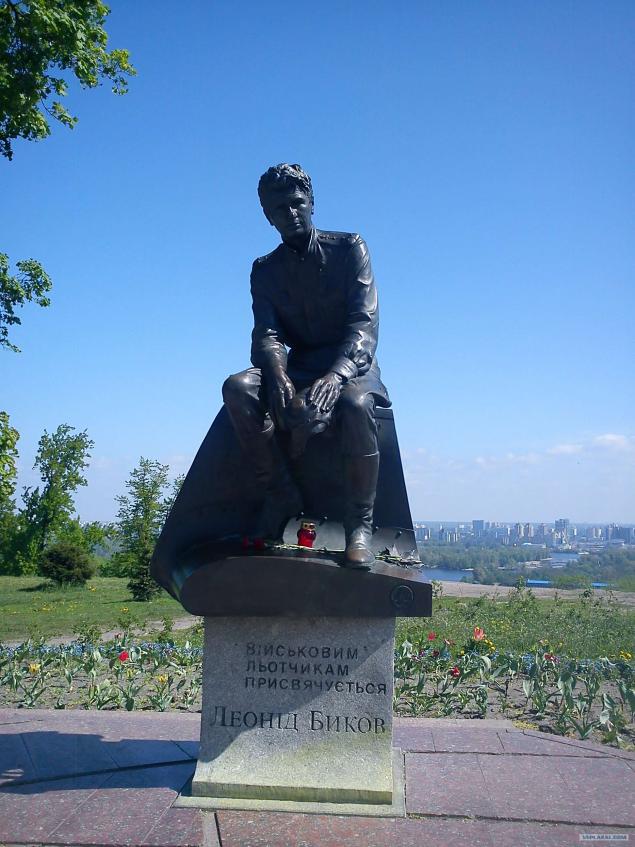
9. After reaching the Mariinsky park next to the Rada (not fotkal it is not scented charms, although such a nice house) depicted a monument to the Commander of the 1st Ukrainian Front, General Nikolai Fyodorovich Vatutin, under whose leadership in 1943, was released Kiev. The monument was erected on the grave of General posthumously (in 1965) became a Hero of the Soviet Union.
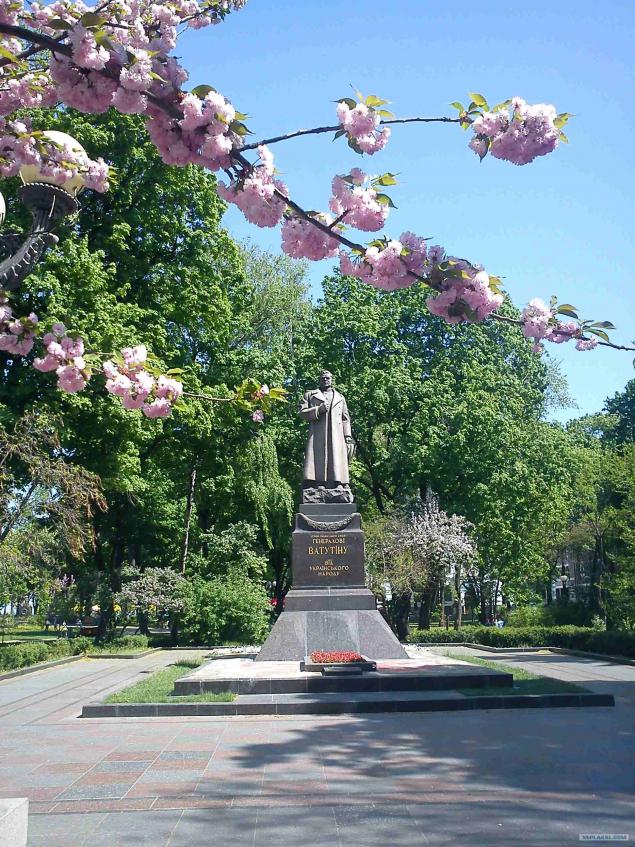
10. At the monument NF Vatutin were planted four cherry, well preserved, only one, the rest of decayed from frost and even a May heat is not able to wake up at least half of the first splendor.
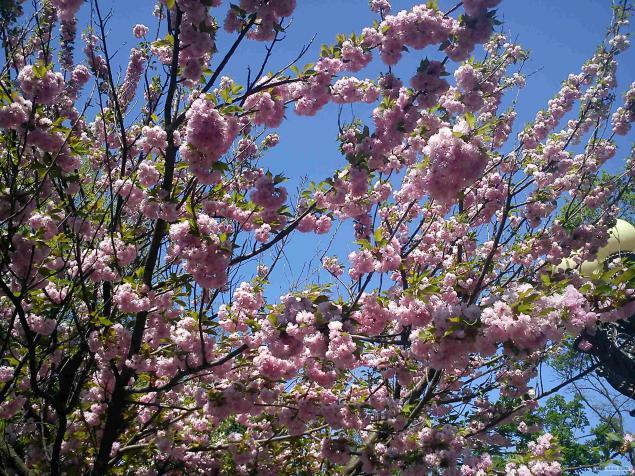
11. I almost forgot, the monument Bykov views of the Kiev-Pechersk Lavra. In this approach I was able to look at it only from this perspective - a mad rush of tourists visiting the many attractions made it physically impossible.
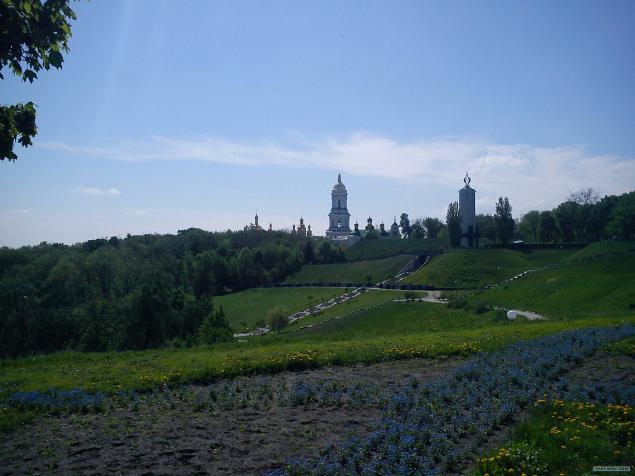
12. I then went on his way toward St. Andrew's descent, the way that I went through Khreshchatyk, which I crossed in exactly at Maidan Nezalezhnosti (something like that in the transcription). Here it is - the view from the rear!
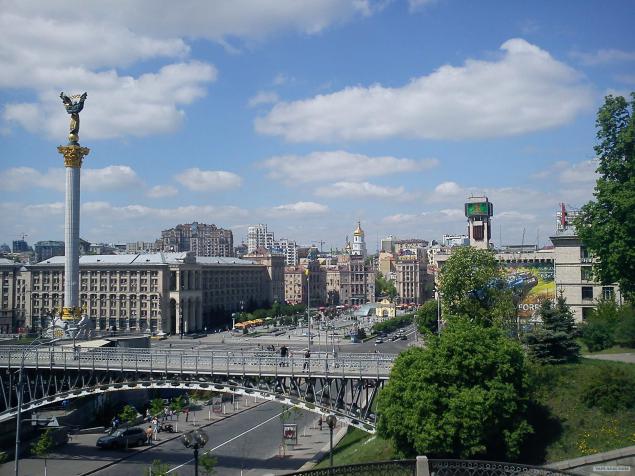
13. Somewhere in the approaches I met a house National Bank of Ukraine - a very nice house, it seemed to me!
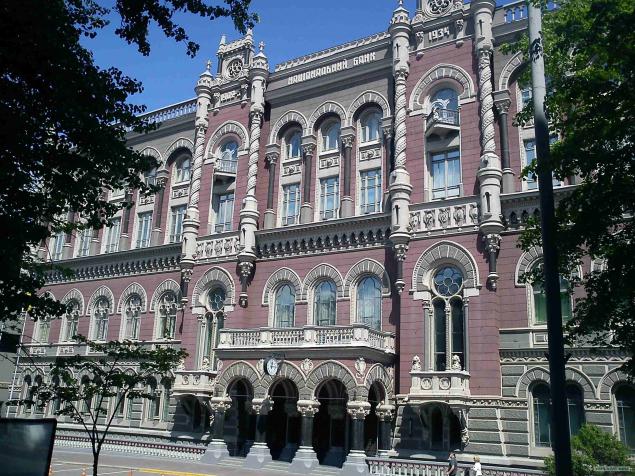
14. This is such beautiful animals here at the corners. A whole object is placed in the house did not want to.
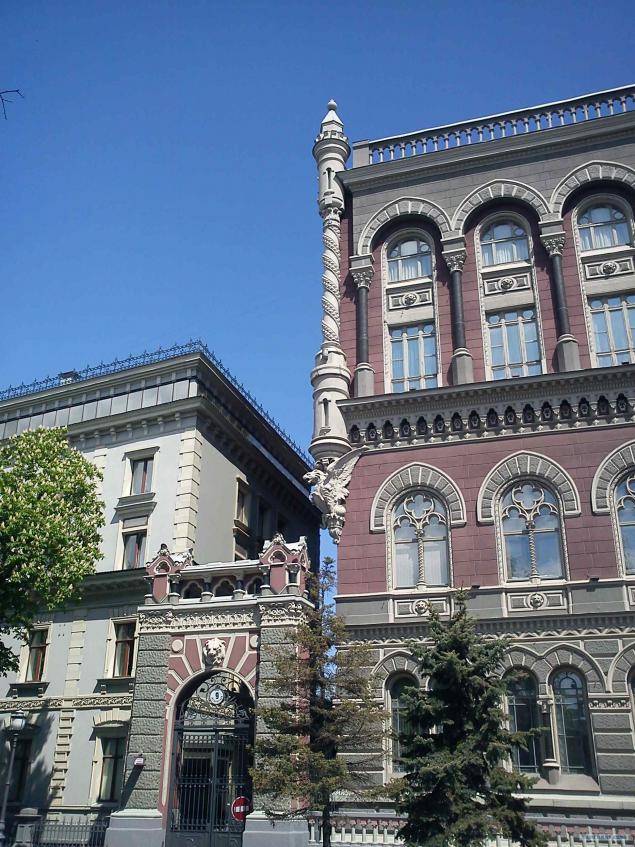
15. I went through the Maidan area of St. Michael, which leaves St. Michael's Monastery, which is located in the newly restored cathedral church of the Archangel Michael (one on the right). Vickie says that it is possibly the first in Russia temple with a gilded top. It Was. In the XII century, long before the destruction and reconstruction. The bell tower is preserved from the XVIII century.
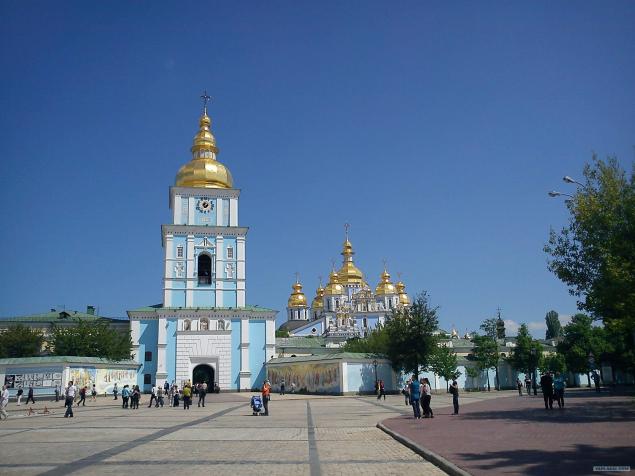
16. Somewhere in the same area in the yards I met the Brazilian Embassy. Nothing like a surprise, except that a wooden house, they were specifically left corner plastered piece to show it. In general, in Kiev remained about a couple dozen wooden houses, that we can say lucky.
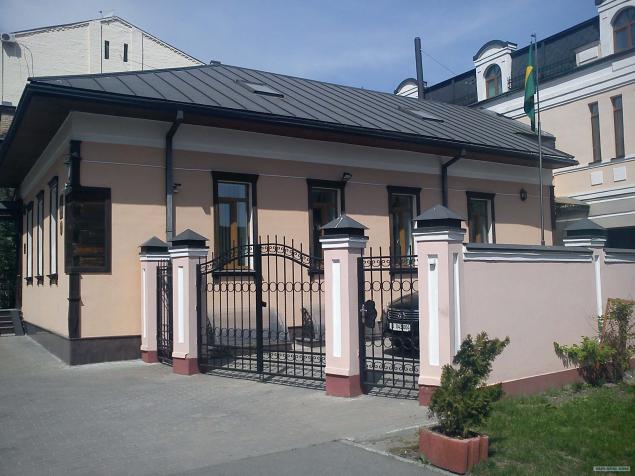
17. Since word for word, I went on the first day with the St. Andrew's descent, and the day after Maksovo pilaf Temin at the yard, I found myself in the grave of Askold ... (who's there Ukrainian movu polyublyaet - even entertain reading) In general, it was found that there is no grave Prince Askold and about Jesuit Novgorod everything is not exactly, but the name was attached long and firmly.
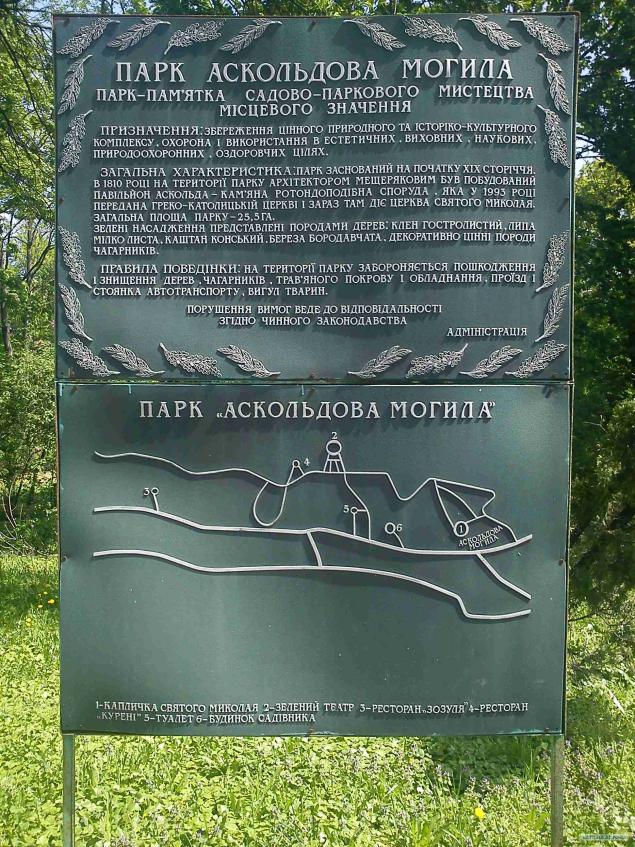
18. It turned out to be not scary, it turns out there a long time ago settled Magyars (ord, the same - to Ugorschiny). Something like: "idosha Ugric past Kiev mountain hedgehog smiling Ugric calls now, and have come to the Dnieper, Stasa vezhami." On that and this and that is embodied in the 1997 erection of the sign.
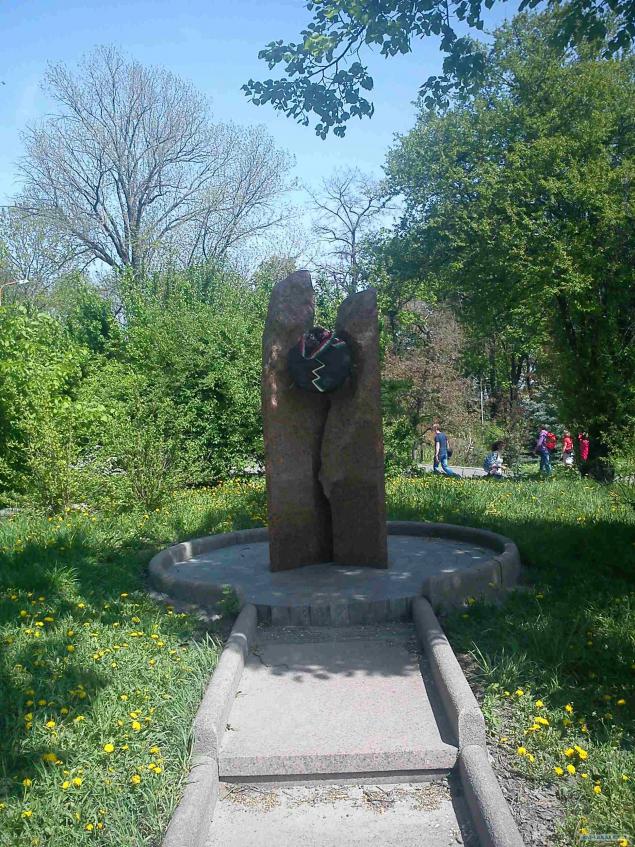
19. In this park stands the church of St. Nicholas Ukrainian Greek Catholic belonging to the Church (also called Uniate from the Union of Brest 1596 on which a portion of the Kyiv Metropolis recognized the supreme jurisdiction of the pope). The church cute, round, but it is very small.
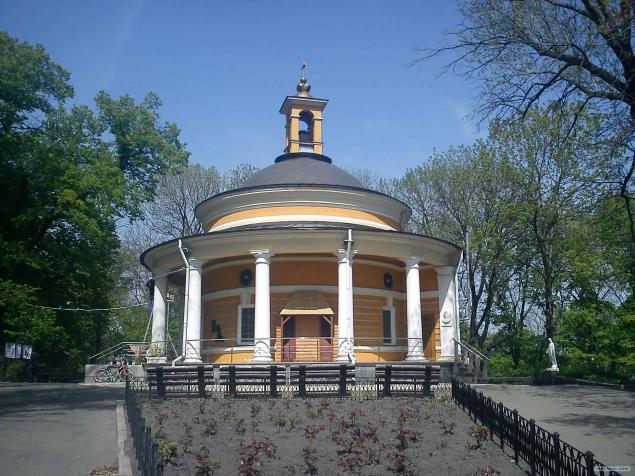
20. so small that during the festive place of worship people are missing entirely, and the icons are hung on trees for the convenience of parishioners nevlezshih (visible in the background). And in the foreground a monument to Heroes of Kruty (mentioned earlier). It was during the civil war in Ukraine, a battle in 1918 near the village of cool when it turned out that regular troops against the Bolsheviks were thrown some students and pupils Ukrainian People's Republic. The story is also very dark, but tightly inflated.
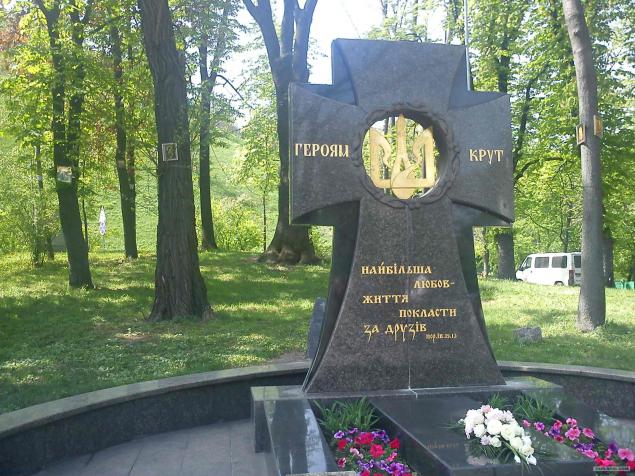
21. Then he brought me to the bus Vudubickiy that previously was located on a steep bank of the Dnieper, Dnieper and then retired from this place, making their dirty deed.
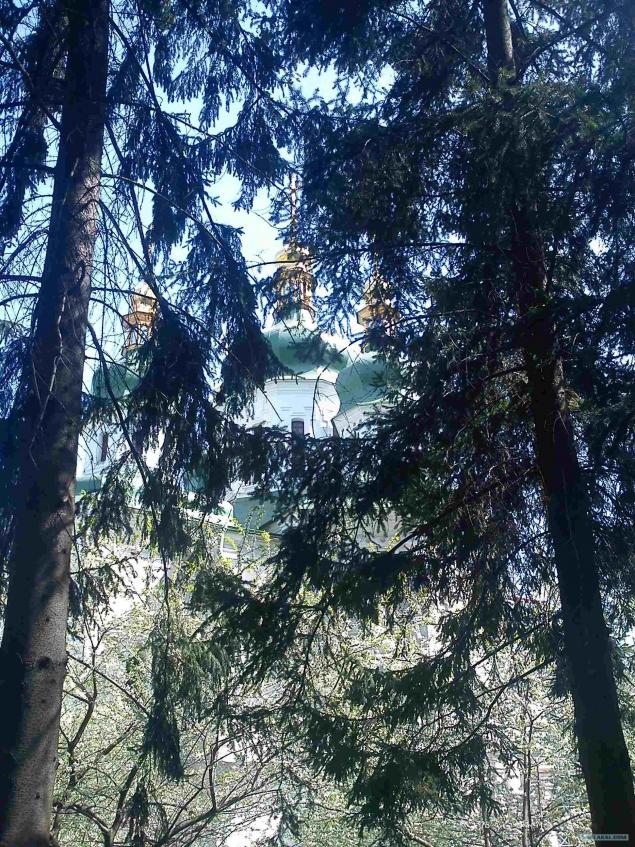
22. And it was this: once (commercials in century XI) St. Michael's Cathedral, according to the chronicles, could not argue with the size and splendor of the Sophia Cathedral. And now he's here is such a very intimate temple. It turns out, built on the site of the coastal pagan temples, the great temple came under threat of destruction because of the waters of the Dnieper, which carefully tempted steep hill on which the temple was located. And despite the fact that in the XII century by the court architect Peter Miloneg was built a unique retaining wall, also hit the record, at one point, in a precisely known, a large part of the church collapsed, along with the shore in the river. Now the front of the left in the historical pink color with good viewing masonry and restoration of coastal whitewashed wall.
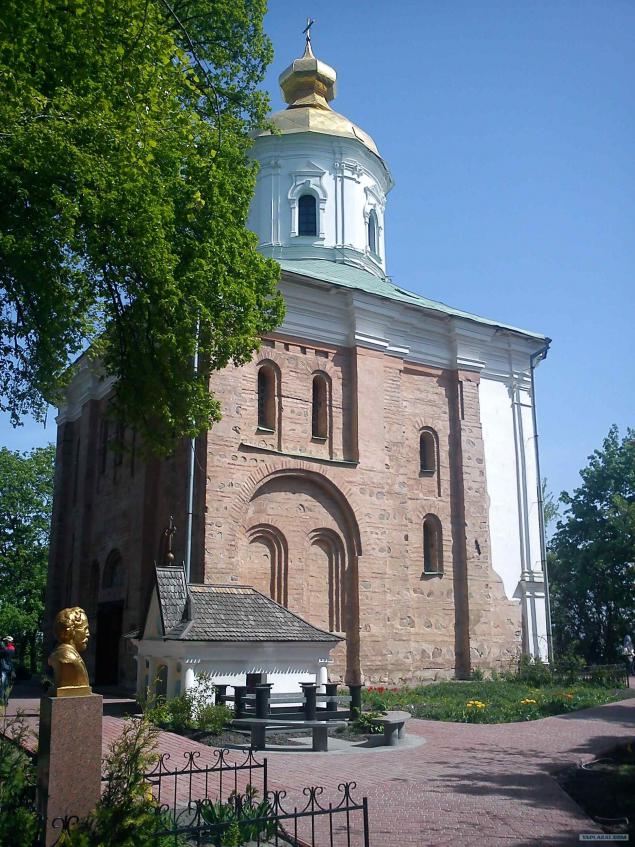
23. The rest of the monastery was built much later, in the traditional style of Ukrainian Baroque (turns out it was my Baroque everywhere!). Here, for example, a row of Lombardy poplars (according to legend, Lombardy poplars is grieving sisters, unlucky Phaeton), hiding fraternal body - behind closed doors.
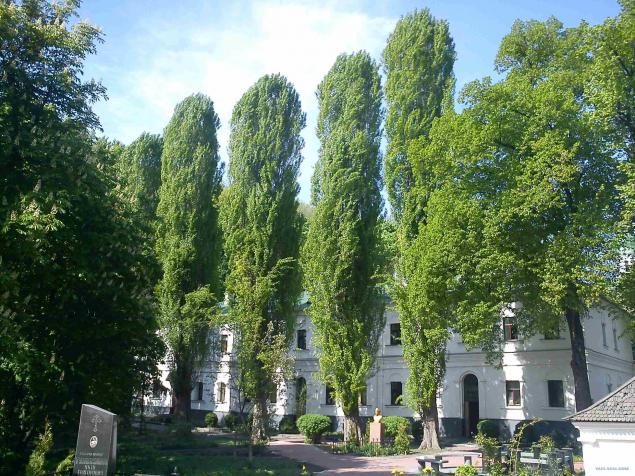
24. In the foreground significantly tombstone - buried here, among many others, Vladimir A. Betz - professor of anatomy at the University of Kiev St. Vladimir. As the inscription on the monument - Prof. Betz founder of the study of the central nervous system, neither more nor less!
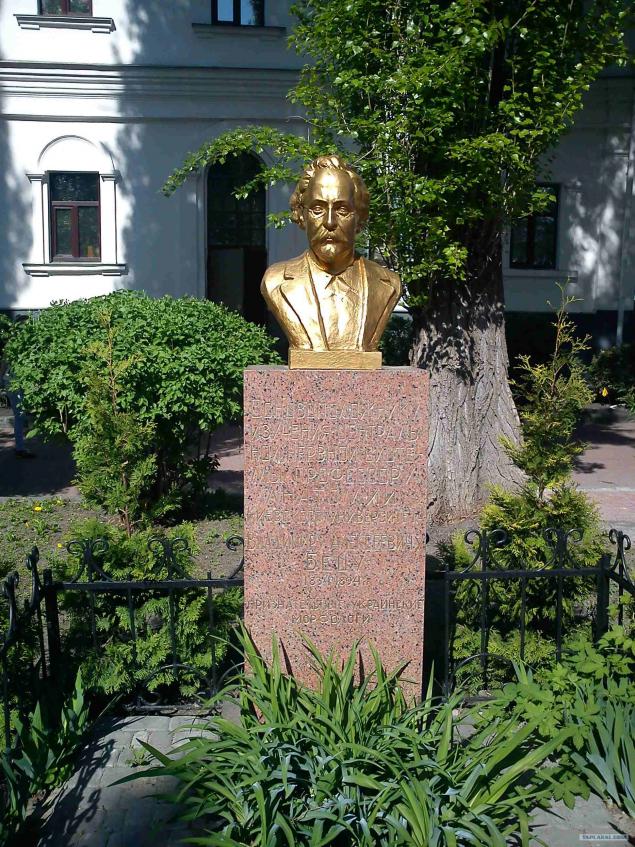
25. On the origin of the name of the place - Vidubichi there is a legend that when, after the baptism of Rus Prince Vladimir Svyatoslavich idols of ancient gods were overthrown, some chopped, which whips bits, and the idol of Perun, the Thunderer was dragged pulled into the Dnieper. The laity in horror anticipating the consequences of the terrible wrath of God ran along the shore of the idol and shouted "Vydubay, Perun!" - Comes up, then, my dear! That's about at this point he swam, then the temple and made conservatives, in its place a monastery and then laid to finally eradicate.
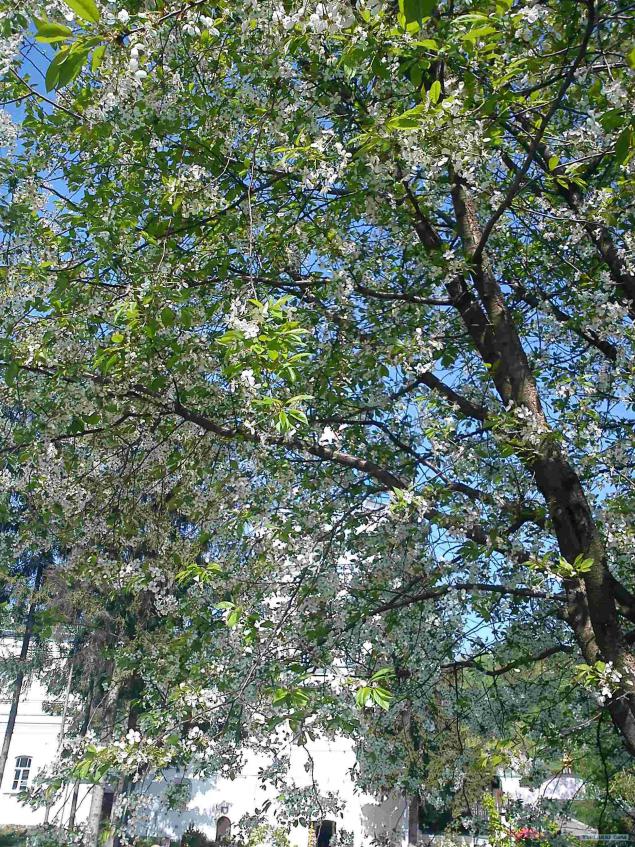
26. The next stop was the Museum of Folk Architecture and Life in Pirogovo. The place is amazing, highly recommend everyone to visit and he is already thinking long trip to at least a few days to devote to acquaintance this very folk architecture. The exhibition still entirely true transported here piece by piece from all over Ukraine houses and buildings. The very exposition is located on the historic districts. The difference between these same areas colossal, and I was able to look only podneprovskuyu part.
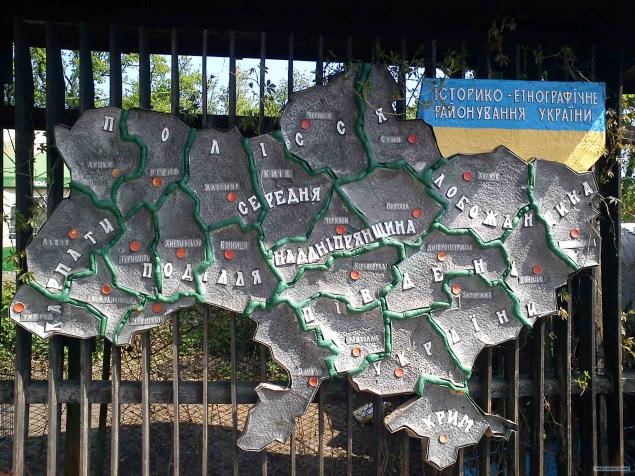
27. At the entrance stand two windmills - windmills. It turns out that here, these houses are not weak on the stone column and can rotate the wind Aki sunflowers follow the sun (live was a girl - my fault).
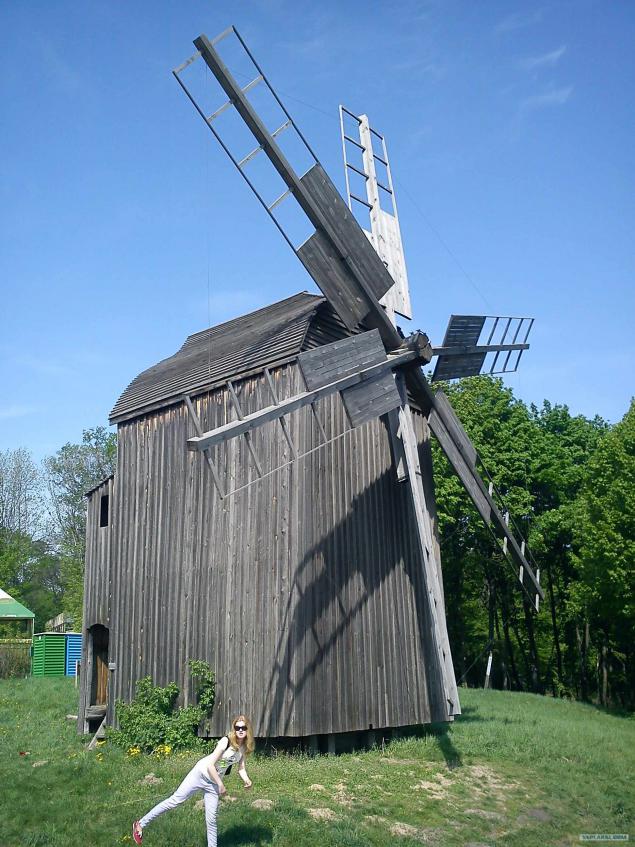
28. It is for 1-2 people is a carrier could turn the whole house in the right direction. Turbine vanes was between 4 and 8 depending on the desired speed and grinding fineness. That's just the higher the speed, the more wear and tear. Therefore, the majority of wind turbines blades of the middle, exactly - 6.
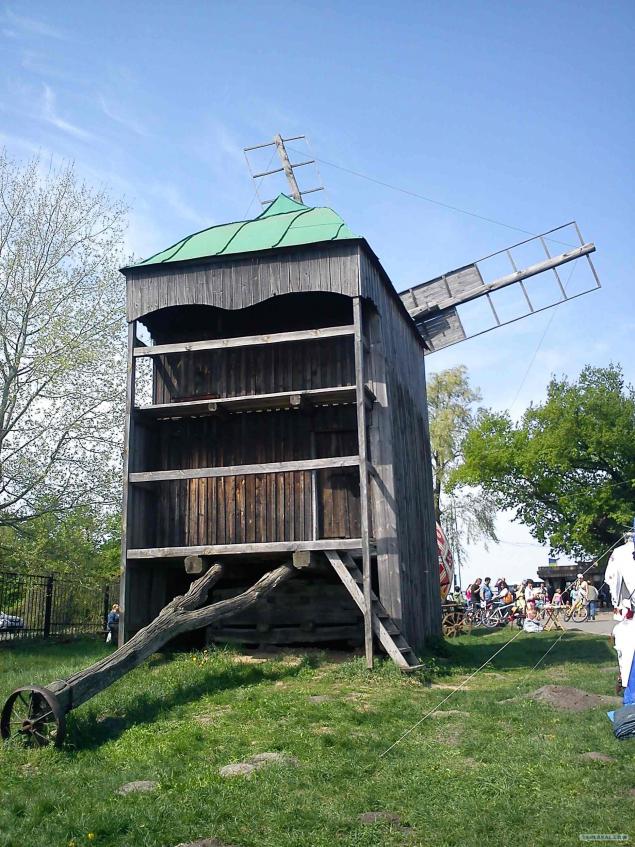
29. Since on the territory of the museum at that moment rushed crowds of tourists anthropoid, good pictures came out very little. And only in fits and starts. Here's a piece about Vidic podnepryanskogo traditional village - this is the same as in once was pse!
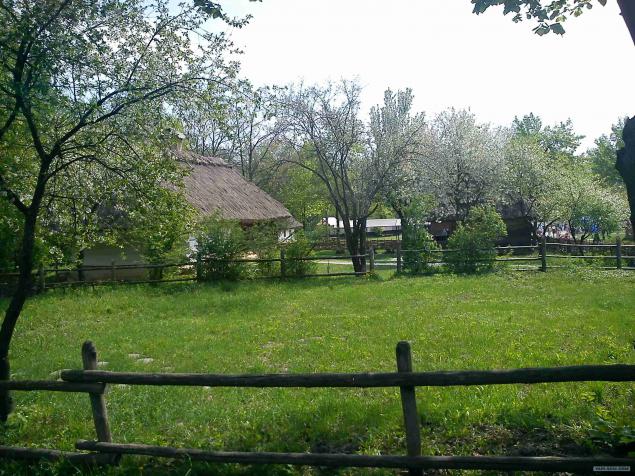
30. Here's another piece. Houses were built on frame technology of wooden boards, coated with clay and belilis. Trees on the banks of the Dnieper was not enough, and the quality of it was not so hot, but it was a lot of mud and good. For richer peasants could not afford to have a house like a skeleton-shield - when between the vertical bars nailed boards. And even they were covering the roof is not just a straw, as much cane. The construction in principle is the same, but the quality is higher.
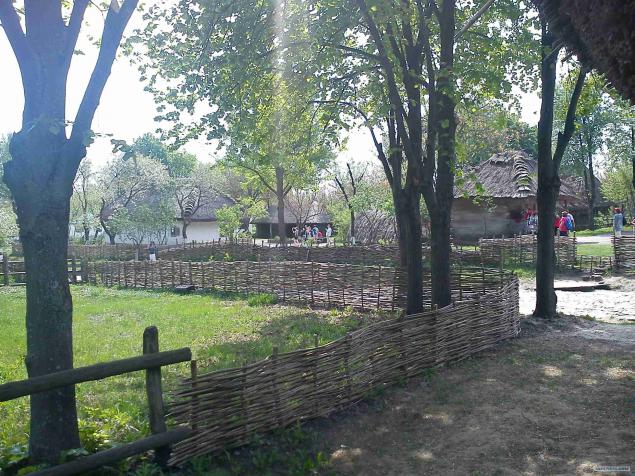
31. The traditional, so-called trёhbannaya (consisting of three standing in a number of compartments, each with its dome) Church of St. Paraskeva XVIII century of Cherkasy region. Built of hewn oak. Tёmnenkaya, ugly, but authentic!
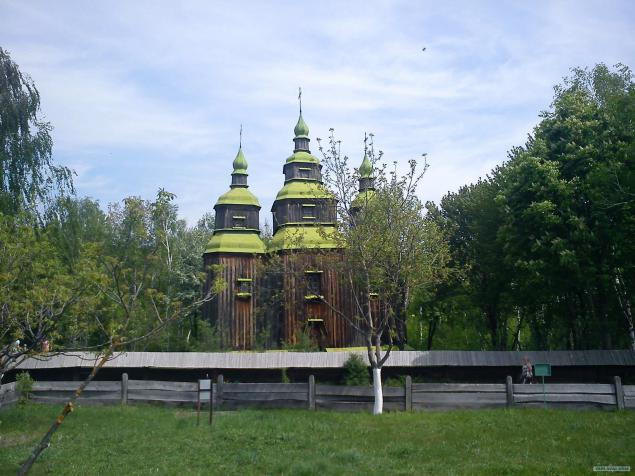
32. Here is such a house with a minimum of suffering, climbing frame, I was able to capture. Where else was a house that belonged to the descendants of Taras Shevchenko, he is about the same. A little bit more and just priyzba (somehow Zavalinka called, is not guaranteed) and he poshibche Tynku lined.
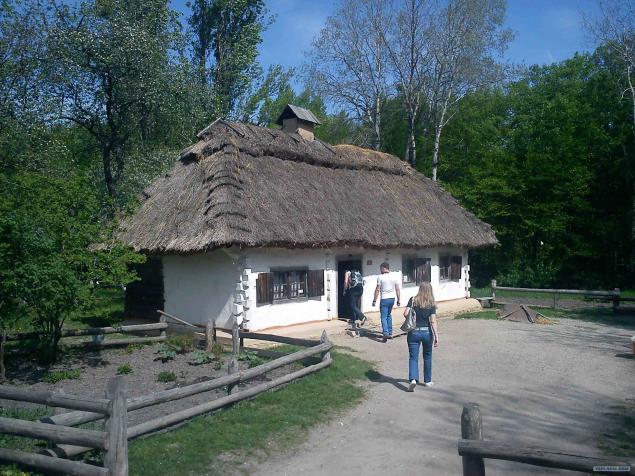
33. But with all the trouble interiors - all turned out in milk for always someone pushing together and strove to kick the elbow. But this is exactly the picture of the house Shevchenko. Even Kobza hanging on the wall - left of rushnichkov. More interior pictures not yet received any. And in general I had to turn around halfway and go back - the time has come to go to the St. Sophia Cathedral (officially) ... and the phone treacherously villages.
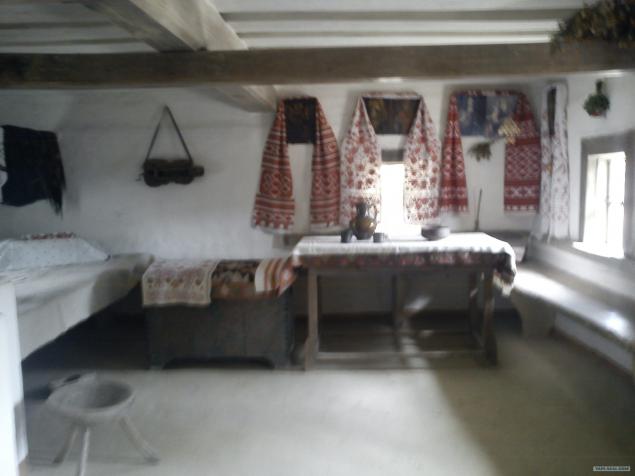
34. The next day, I first went to the Botanical Gardens of the National Academy of Sciences of Ukraine. For the city began to rapidly blooming lilacs, and Boat. It claimed was an extensive garden ... serengary, in which the word! Here on this track, and I rushed to the side of the most lilacs.
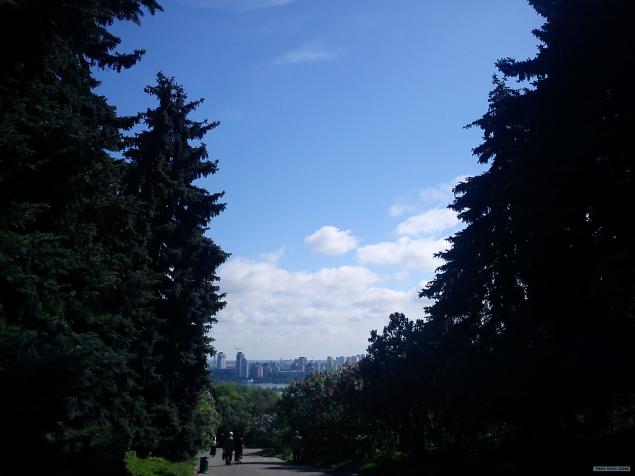
35. But the violent flowering, I did not find, now it is probably already there, and then had to choose whatever piece sfotkat. Here is such a piece, for example.
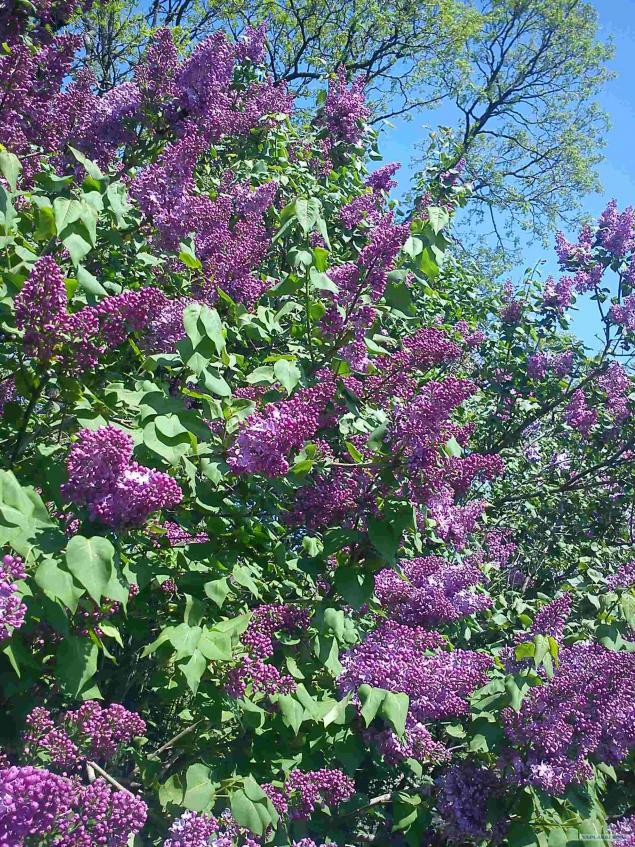
36. And so, for example. Well, sort of, but not what was expected. Who goes, tell us when this thing started a riot I still podedu =)
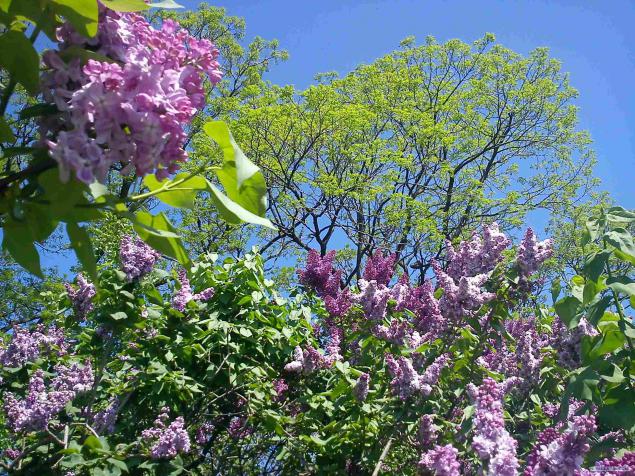
37. Next growing tree that flowers are not stingy. Who specials then tell what kind of cherry / apple tree or some other abrikosina.
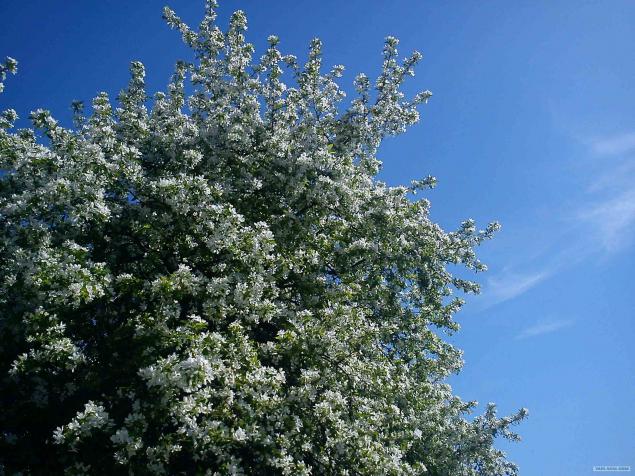
38. Here I am sprig specially made for closer!
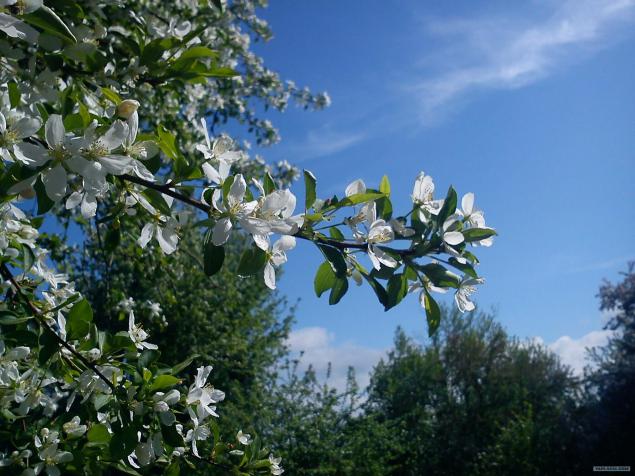
39. After leaving the garden again, I sure step towards the coveted toward St. Andrew's Descent. Somewhere jumped avtobusike but more pёhom. In the immediate vicinity - in the Tithe street I zapilsya sleeve sticking out of the wall ... nose. They say - Gogol. But the eyes are clearly not the same ... and it (rock, her mother, painting). It is believed that the loss of the nose can be easy to get rid of the common cold - not tested.
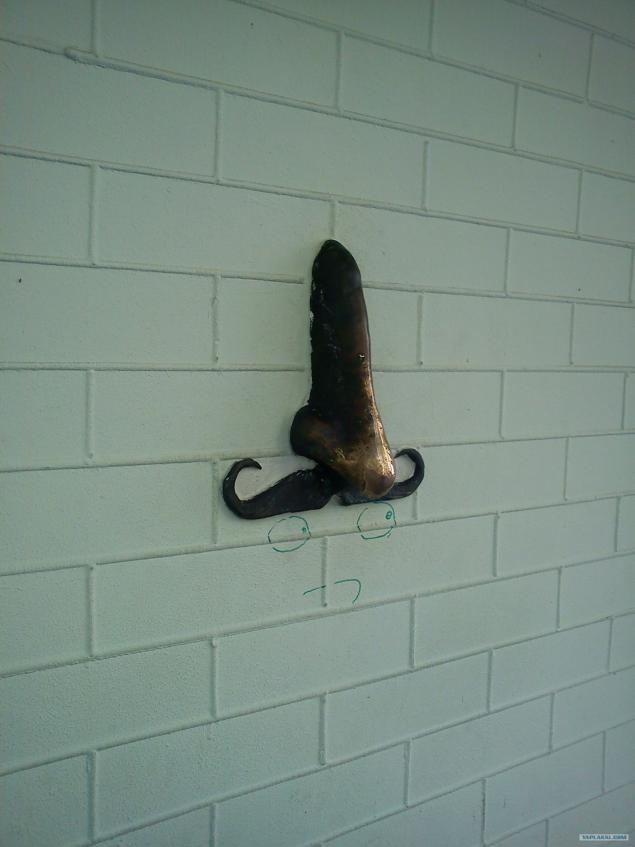
40. On the other side of the street in the vicinity of St. Andrew's Church stood, bowed his knee before the beauty of Prony Prokopovna, Svirid Petrovich Golokhvastov person. Rub, I understand, made a beetle on a frock coat and a bust of Madame Golohvastov Prony!
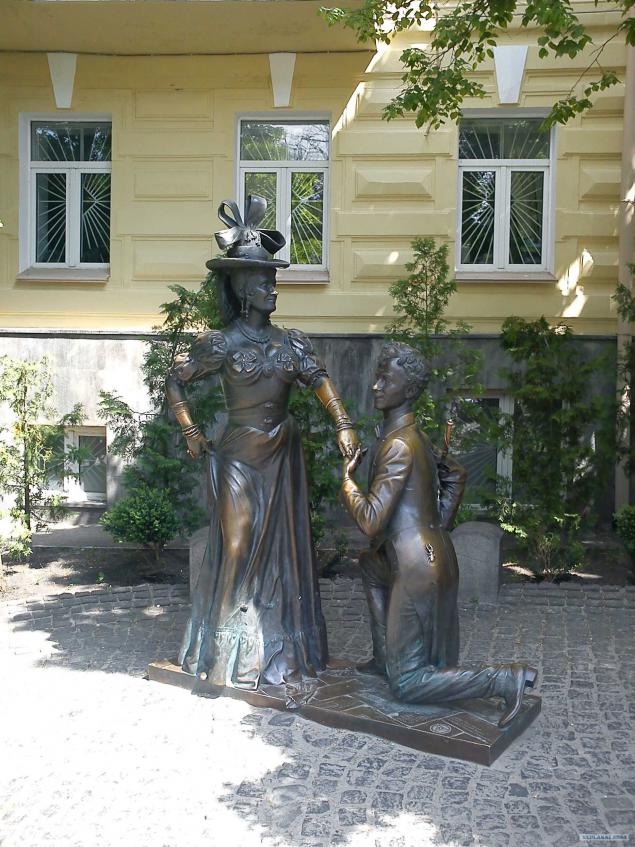
41. And here she is, my beauty. St. Andrew's Church - unloved, but outstanding child Rastrelli. Incredibly good and playing the most delicate strings of my poor soul.
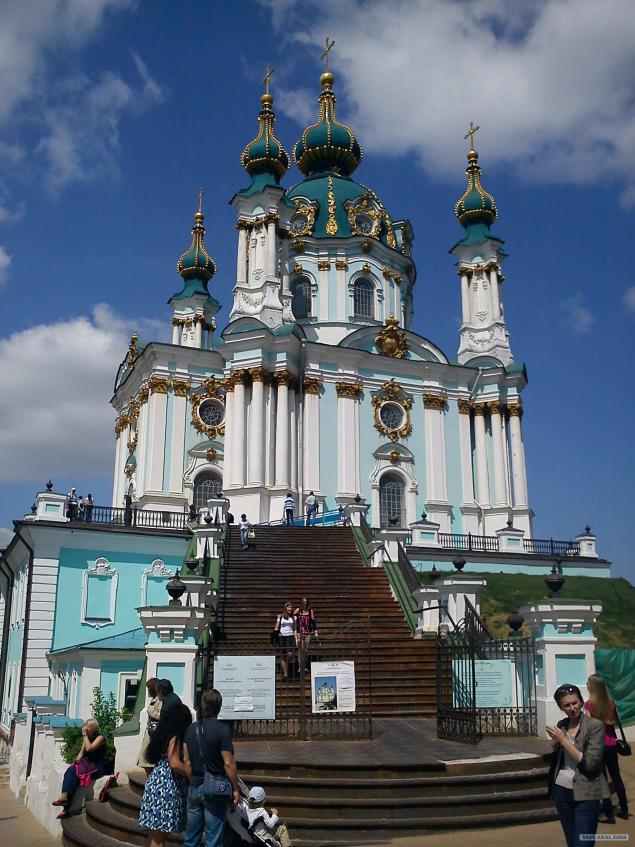
42. And here is the view of the slope itself! In the center of the original house from the upper part of zamkopodobnoy - Richard House, a haunted house, a house with hapless fate. Once the owner has decided to make the original a la Gothic hotel, but died. Wife has canceled all Gothic and had a fight with the builders. Complete construction of a conventional design, and finally inserted into the pipe bottlenecks. Guests have called first - and at night in the pipes so buzzed that the morning had many ghosts seen. With the fate of the hotel did not work out. Then there who not only lived, particularly toy maker with a rare name Richard. The children all the time he disappeared in the courtyard, and the house eventually became named. But then again that is not grown together, and then again ... so he now stands derelict and boarded up.

43. The house №13 hiding in the shade on a bench lonely Bulgakov. That's just stay alone it is not very give - to sit on a bench near the Masters is all of the suffering! Barely broke through, what to do - season. We come in large numbers here.
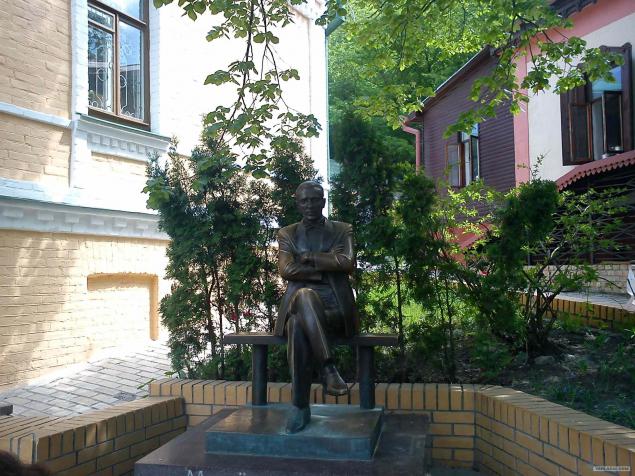
44. And here is the Mikhail Bulgakov Museum, even the house number plaque indicating Alexis descent.
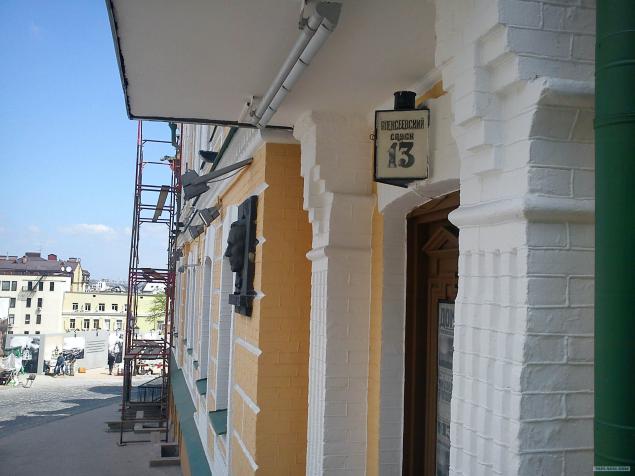
45. At the end of Andrew's descent are elegant houses, one of which houses a museum of one street, entirely dedicated to the history of St. Andrew's Descent. Incidentally, in the Ukrainian language to refer to such non-sloping streets of the word vzviz, which does not specify - descent or climb it. And generally speaking, the house numbering goes from the bottom up. So the descent or ascent is debatable (many tourists do).
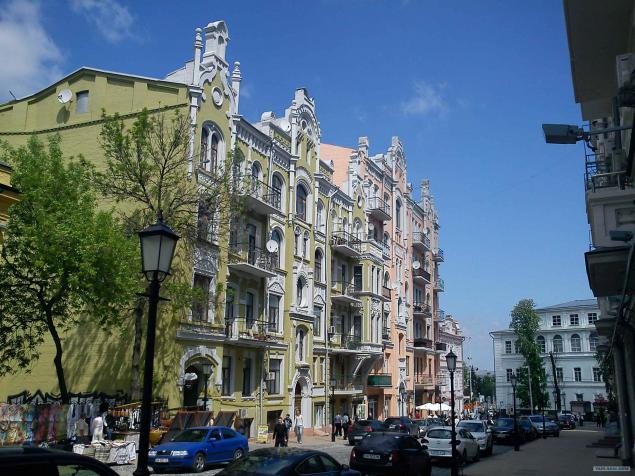
46. Before leaving I visited, as I said, the only remarkable place on the left bank - Park Kyoto. If Moscow takes his sister cities operating the capital, Kiev - the ancient. That's ancient capital of Japan came to this narrow circle. Under this deal broke the eponymous park, with the inevitable small pagoda and pond (no carp). And also planted alley cherries grafted branches Sakura.
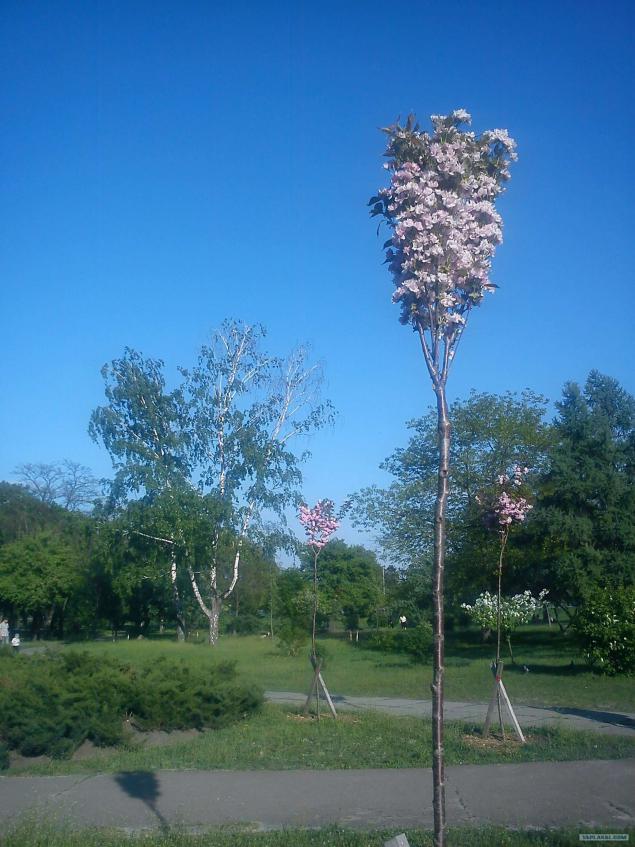
47. They landed just, grow briskly, they did not have time, but something that can already be assessed.
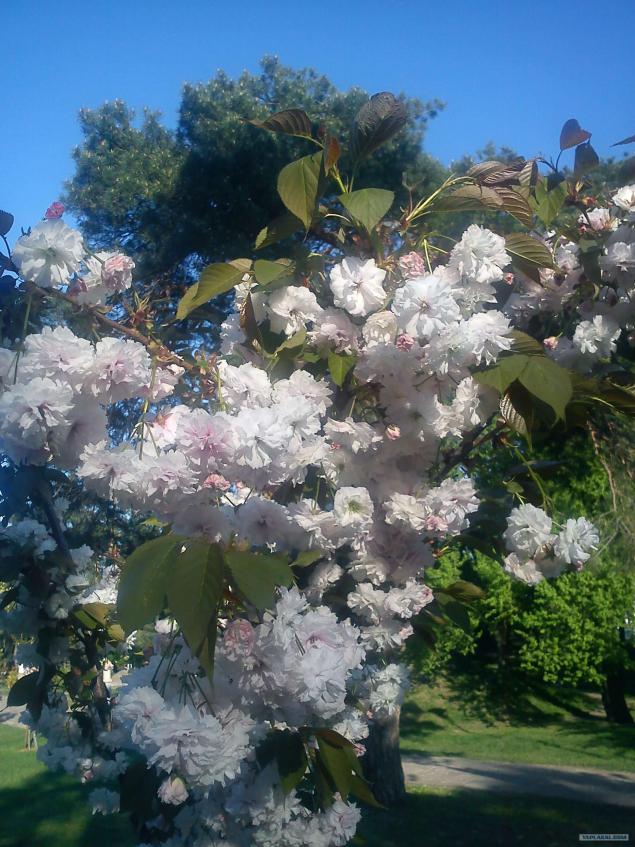
48. Let's hope that at least the majority of them will be able to settle down and get used to the relatively cool climate of Kiev.
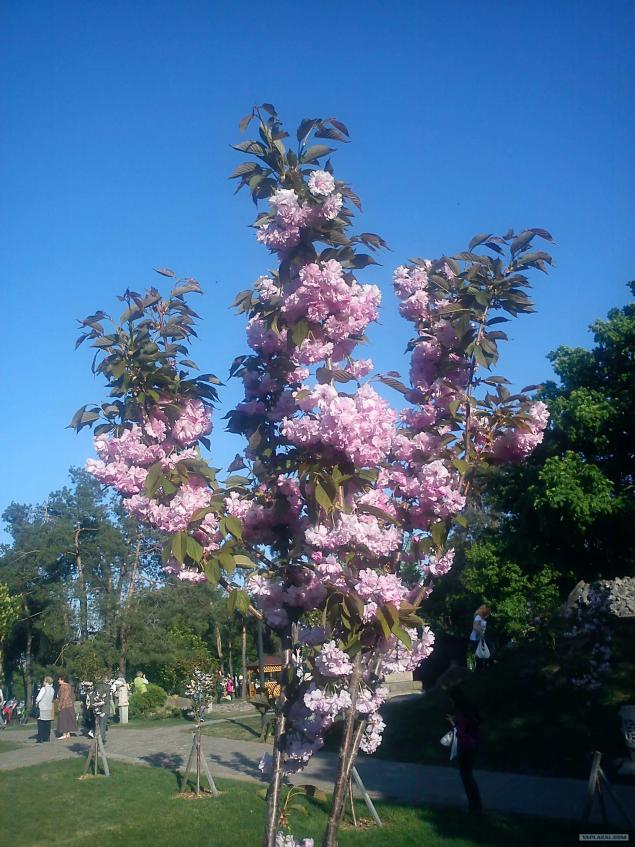
Source:
Monument to the founders of Kiev - Polyansky princes Kyi, Schek, Horeb and their sister Lybid. Despite the fact that the monument was opened only in 1982, it can rightly be called one of the most recognizable symbols of the city. On the square in front of the monument is constantly stop wedding procession. According to local custom, we must try to throw the bouquet on the sloping deck boat and then a happy marriage provided!

2. Close lurking lock tree - task to be easier for those with throwing bouquets did not succeed!

3. A boat rages behind the Dnieper.

4. In contrast, on the right bank of the Dnieper rises the monument to Motherland, who with a light hand opens a monument to Leonid Ilyich (zvukorezha and carefully includes not just the microphone) was named Baba. And Baba colossal sword - 9 m., Panel - 13 tons. The spectacle is impressive even from a distance. Closer this time to get close failed.

5. In the Park of Eternal Glory tourists were few, but they were scattered so gracefully that constantly climbed into the frame, and had to take a picture vlёt. So horizon ... Go to the monument of Eternal Glory with the eternal fire leads a small alley which transferred 35 military graves, 12 of them - Heroes of the Soviet Union.

6. Next to the park is a monument to Ivan Niktovichu Kozhedub, the most effective Soviet ace of Great Patriotic War. Ivan himself Nikitivich native of Sumy region.

7. From the park offers a beautiful view on the left bank of the Dnieper. Only my phone this estimate does not, but if you're there - understand!

8. A little away from the park on the Alley of Heroes Krut (about them later) installed very sincere small monument to Leonid Bykov in the form of squadron leader Titorenko dedicated to military pilots.

9. After reaching the Mariinsky park next to the Rada (not fotkal it is not scented charms, although such a nice house) depicted a monument to the Commander of the 1st Ukrainian Front, General Nikolai Fyodorovich Vatutin, under whose leadership in 1943, was released Kiev. The monument was erected on the grave of General posthumously (in 1965) became a Hero of the Soviet Union.

10. At the monument NF Vatutin were planted four cherry, well preserved, only one, the rest of decayed from frost and even a May heat is not able to wake up at least half of the first splendor.

11. I almost forgot, the monument Bykov views of the Kiev-Pechersk Lavra. In this approach I was able to look at it only from this perspective - a mad rush of tourists visiting the many attractions made it physically impossible.

12. I then went on his way toward St. Andrew's descent, the way that I went through Khreshchatyk, which I crossed in exactly at Maidan Nezalezhnosti (something like that in the transcription). Here it is - the view from the rear!

13. Somewhere in the approaches I met a house National Bank of Ukraine - a very nice house, it seemed to me!

14. This is such beautiful animals here at the corners. A whole object is placed in the house did not want to.

15. I went through the Maidan area of St. Michael, which leaves St. Michael's Monastery, which is located in the newly restored cathedral church of the Archangel Michael (one on the right). Vickie says that it is possibly the first in Russia temple with a gilded top. It Was. In the XII century, long before the destruction and reconstruction. The bell tower is preserved from the XVIII century.

16. Somewhere in the same area in the yards I met the Brazilian Embassy. Nothing like a surprise, except that a wooden house, they were specifically left corner plastered piece to show it. In general, in Kiev remained about a couple dozen wooden houses, that we can say lucky.

17. Since word for word, I went on the first day with the St. Andrew's descent, and the day after Maksovo pilaf Temin at the yard, I found myself in the grave of Askold ... (who's there Ukrainian movu polyublyaet - even entertain reading) In general, it was found that there is no grave Prince Askold and about Jesuit Novgorod everything is not exactly, but the name was attached long and firmly.

18. It turned out to be not scary, it turns out there a long time ago settled Magyars (ord, the same - to Ugorschiny). Something like: "idosha Ugric past Kiev mountain hedgehog smiling Ugric calls now, and have come to the Dnieper, Stasa vezhami." On that and this and that is embodied in the 1997 erection of the sign.

19. In this park stands the church of St. Nicholas Ukrainian Greek Catholic belonging to the Church (also called Uniate from the Union of Brest 1596 on which a portion of the Kyiv Metropolis recognized the supreme jurisdiction of the pope). The church cute, round, but it is very small.

20. so small that during the festive place of worship people are missing entirely, and the icons are hung on trees for the convenience of parishioners nevlezshih (visible in the background). And in the foreground a monument to Heroes of Kruty (mentioned earlier). It was during the civil war in Ukraine, a battle in 1918 near the village of cool when it turned out that regular troops against the Bolsheviks were thrown some students and pupils Ukrainian People's Republic. The story is also very dark, but tightly inflated.

21. Then he brought me to the bus Vudubickiy that previously was located on a steep bank of the Dnieper, Dnieper and then retired from this place, making their dirty deed.

22. And it was this: once (commercials in century XI) St. Michael's Cathedral, according to the chronicles, could not argue with the size and splendor of the Sophia Cathedral. And now he's here is such a very intimate temple. It turns out, built on the site of the coastal pagan temples, the great temple came under threat of destruction because of the waters of the Dnieper, which carefully tempted steep hill on which the temple was located. And despite the fact that in the XII century by the court architect Peter Miloneg was built a unique retaining wall, also hit the record, at one point, in a precisely known, a large part of the church collapsed, along with the shore in the river. Now the front of the left in the historical pink color with good viewing masonry and restoration of coastal whitewashed wall.

23. The rest of the monastery was built much later, in the traditional style of Ukrainian Baroque (turns out it was my Baroque everywhere!). Here, for example, a row of Lombardy poplars (according to legend, Lombardy poplars is grieving sisters, unlucky Phaeton), hiding fraternal body - behind closed doors.

24. In the foreground significantly tombstone - buried here, among many others, Vladimir A. Betz - professor of anatomy at the University of Kiev St. Vladimir. As the inscription on the monument - Prof. Betz founder of the study of the central nervous system, neither more nor less!

25. On the origin of the name of the place - Vidubichi there is a legend that when, after the baptism of Rus Prince Vladimir Svyatoslavich idols of ancient gods were overthrown, some chopped, which whips bits, and the idol of Perun, the Thunderer was dragged pulled into the Dnieper. The laity in horror anticipating the consequences of the terrible wrath of God ran along the shore of the idol and shouted "Vydubay, Perun!" - Comes up, then, my dear! That's about at this point he swam, then the temple and made conservatives, in its place a monastery and then laid to finally eradicate.

26. The next stop was the Museum of Folk Architecture and Life in Pirogovo. The place is amazing, highly recommend everyone to visit and he is already thinking long trip to at least a few days to devote to acquaintance this very folk architecture. The exhibition still entirely true transported here piece by piece from all over Ukraine houses and buildings. The very exposition is located on the historic districts. The difference between these same areas colossal, and I was able to look only podneprovskuyu part.

27. At the entrance stand two windmills - windmills. It turns out that here, these houses are not weak on the stone column and can rotate the wind Aki sunflowers follow the sun (live was a girl - my fault).

28. It is for 1-2 people is a carrier could turn the whole house in the right direction. Turbine vanes was between 4 and 8 depending on the desired speed and grinding fineness. That's just the higher the speed, the more wear and tear. Therefore, the majority of wind turbines blades of the middle, exactly - 6.

29. Since on the territory of the museum at that moment rushed crowds of tourists anthropoid, good pictures came out very little. And only in fits and starts. Here's a piece about Vidic podnepryanskogo traditional village - this is the same as in once was pse!

30. Here's another piece. Houses were built on frame technology of wooden boards, coated with clay and belilis. Trees on the banks of the Dnieper was not enough, and the quality of it was not so hot, but it was a lot of mud and good. For richer peasants could not afford to have a house like a skeleton-shield - when between the vertical bars nailed boards. And even they were covering the roof is not just a straw, as much cane. The construction in principle is the same, but the quality is higher.

31. The traditional, so-called trёhbannaya (consisting of three standing in a number of compartments, each with its dome) Church of St. Paraskeva XVIII century of Cherkasy region. Built of hewn oak. Tёmnenkaya, ugly, but authentic!

32. Here is such a house with a minimum of suffering, climbing frame, I was able to capture. Where else was a house that belonged to the descendants of Taras Shevchenko, he is about the same. A little bit more and just priyzba (somehow Zavalinka called, is not guaranteed) and he poshibche Tynku lined.

33. But with all the trouble interiors - all turned out in milk for always someone pushing together and strove to kick the elbow. But this is exactly the picture of the house Shevchenko. Even Kobza hanging on the wall - left of rushnichkov. More interior pictures not yet received any. And in general I had to turn around halfway and go back - the time has come to go to the St. Sophia Cathedral (officially) ... and the phone treacherously villages.

34. The next day, I first went to the Botanical Gardens of the National Academy of Sciences of Ukraine. For the city began to rapidly blooming lilacs, and Boat. It claimed was an extensive garden ... serengary, in which the word! Here on this track, and I rushed to the side of the most lilacs.

35. But the violent flowering, I did not find, now it is probably already there, and then had to choose whatever piece sfotkat. Here is such a piece, for example.

36. And so, for example. Well, sort of, but not what was expected. Who goes, tell us when this thing started a riot I still podedu =)

37. Next growing tree that flowers are not stingy. Who specials then tell what kind of cherry / apple tree or some other abrikosina.

38. Here I am sprig specially made for closer!

39. After leaving the garden again, I sure step towards the coveted toward St. Andrew's Descent. Somewhere jumped avtobusike but more pёhom. In the immediate vicinity - in the Tithe street I zapilsya sleeve sticking out of the wall ... nose. They say - Gogol. But the eyes are clearly not the same ... and it (rock, her mother, painting). It is believed that the loss of the nose can be easy to get rid of the common cold - not tested.

40. On the other side of the street in the vicinity of St. Andrew's Church stood, bowed his knee before the beauty of Prony Prokopovna, Svirid Petrovich Golokhvastov person. Rub, I understand, made a beetle on a frock coat and a bust of Madame Golohvastov Prony!

41. And here she is, my beauty. St. Andrew's Church - unloved, but outstanding child Rastrelli. Incredibly good and playing the most delicate strings of my poor soul.

42. And here is the view of the slope itself! In the center of the original house from the upper part of zamkopodobnoy - Richard House, a haunted house, a house with hapless fate. Once the owner has decided to make the original a la Gothic hotel, but died. Wife has canceled all Gothic and had a fight with the builders. Complete construction of a conventional design, and finally inserted into the pipe bottlenecks. Guests have called first - and at night in the pipes so buzzed that the morning had many ghosts seen. With the fate of the hotel did not work out. Then there who not only lived, particularly toy maker with a rare name Richard. The children all the time he disappeared in the courtyard, and the house eventually became named. But then again that is not grown together, and then again ... so he now stands derelict and boarded up.

43. The house №13 hiding in the shade on a bench lonely Bulgakov. That's just stay alone it is not very give - to sit on a bench near the Masters is all of the suffering! Barely broke through, what to do - season. We come in large numbers here.

44. And here is the Mikhail Bulgakov Museum, even the house number plaque indicating Alexis descent.

45. At the end of Andrew's descent are elegant houses, one of which houses a museum of one street, entirely dedicated to the history of St. Andrew's Descent. Incidentally, in the Ukrainian language to refer to such non-sloping streets of the word vzviz, which does not specify - descent or climb it. And generally speaking, the house numbering goes from the bottom up. So the descent or ascent is debatable (many tourists do).

46. Before leaving I visited, as I said, the only remarkable place on the left bank - Park Kyoto. If Moscow takes his sister cities operating the capital, Kiev - the ancient. That's ancient capital of Japan came to this narrow circle. Under this deal broke the eponymous park, with the inevitable small pagoda and pond (no carp). And also planted alley cherries grafted branches Sakura.

47. They landed just, grow briskly, they did not have time, but something that can already be assessed.

48. Let's hope that at least the majority of them will be able to settle down and get used to the relatively cool climate of Kiev.

Source:
